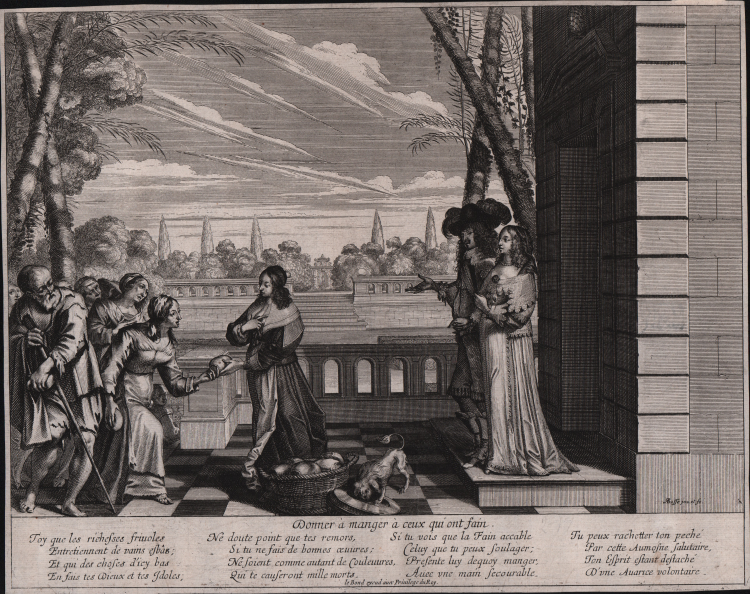




| Reference: | S37765 |
| Author | Abraham Bosse |
| Year: | 1635 ca. |
| Measures: | 326 x 260 mm |



| Reference: | S37765 |
| Author | Abraham Bosse |
| Year: | 1635 ca. |
| Measures: | 326 x 260 mm |
Etching, and engraving, 1635 circa, signed at bottom right, in the image ABosse jnu. et fe”.
In the lower margin, in the center, the title “Donner à manger ò ceux qui ont fain”, then 14 French verses on four columns: Toy que les richesses friuoles / Entretiennent de vains esbâs ; / Et qui des choses d'icy bas / En fais tes Dieux et tes Jdoles ; // Ne doute point que tes remors, / Si tu ne fais de bonnes ouures ; / Ne soient comme autant de Couleuures, / Qui te causeront mille morts. // Si tu vois que la Fain accable / Celuy que tu peux soulager ; / Presente luy dequoy manger, / Auec vne main secourable. // Tu peux rachetter ton peché / Par cette Aumosne salutaire, / Ton Esprit estant detaché / D'vne Auarice volontaire.
At bottom centre: LeBond excud avec Prilvilege du Roy”. First state of two.
Good example, printed on contemporary laid paper, trimmed at margins, in very good condition.
From the series “Ouvres de miséricorde” of seven plates.
On the terrace of a rich house, beyond which extends a sumptuous garden, a servant distributes bread to the poor. With a gesture of the hand, she indicates the origin of this generous gift, the couple of wealthy bourgeois who stands on the threshold.
The origin of the theme of the Ouvres de miséricorde is in the Gospel of St. Matthew (XXV, 34-36). According to Luther and Calvin, recalls Jean-Claude Boyer after Émile Mâle (Arte religiosa dopo il Concilio di Trento, Paris, 1932, pp. 86-96), "good works do not contribute in any way to salvation". The Catholic Church replies that faith can not save without charity. By engraving an important series of pieces on the theme of the works of mercy, which is not so common, Abraham Bosse is therefore at odds with his fellow believers. This brings up many questions: on Protestantism Bosse first, perhaps more inherited than convinced; on the sponsor, who can be the publisher, if the initiative does not come from the engraver; if the engraver did not want to be seen well; if there is no dispute about the works within the Huguenot community itself.
|
Abraham Bosse savant graverus, n. 182, p. 208.
|
Abraham Bosse (Tours 1604 circa – Parigi 1676)
|
Abraham Bosse was a French artist, mainly as a printmaker in etching, but also in watercolour. Roughly 1500 etchings are attributed to him, and give fascinating and informative detail about middle and upper-class daily life in the period. In 1641 he began to attend classes given by the architect Girard Desargues (1591–1661) on perspective and other technical aspects of depiction. Bosse not only adopted these methods but also published a series of works between 1643–1653 explaining and promoting them. In 1648, when Cardinal Mazarin established the Académie royale de peinture et de sculpture, Bosse was made a founding member. However his publicising of Desargues' methods embroiled him in a controversy with Charles Le Brun and his followers who had different methods, and also a belief that "genius" rather than technical method should be the guide in creating artworks. In 1661 Bosse was forced to withdraw from the Academy; he established his own school as an alternative.
|
|
Abraham Bosse savant graverus, n. 182, p. 208.
|
Abraham Bosse (Tours 1604 circa – Parigi 1676)
|
Abraham Bosse was a French artist, mainly as a printmaker in etching, but also in watercolour. Roughly 1500 etchings are attributed to him, and give fascinating and informative detail about middle and upper-class daily life in the period. In 1641 he began to attend classes given by the architect Girard Desargues (1591–1661) on perspective and other technical aspects of depiction. Bosse not only adopted these methods but also published a series of works between 1643–1653 explaining and promoting them. In 1648, when Cardinal Mazarin established the Académie royale de peinture et de sculpture, Bosse was made a founding member. However his publicising of Desargues' methods embroiled him in a controversy with Charles Le Brun and his followers who had different methods, and also a belief that "genius" rather than technical method should be the guide in creating artworks. In 1661 Bosse was forced to withdraw from the Academy; he established his own school as an alternative.
|